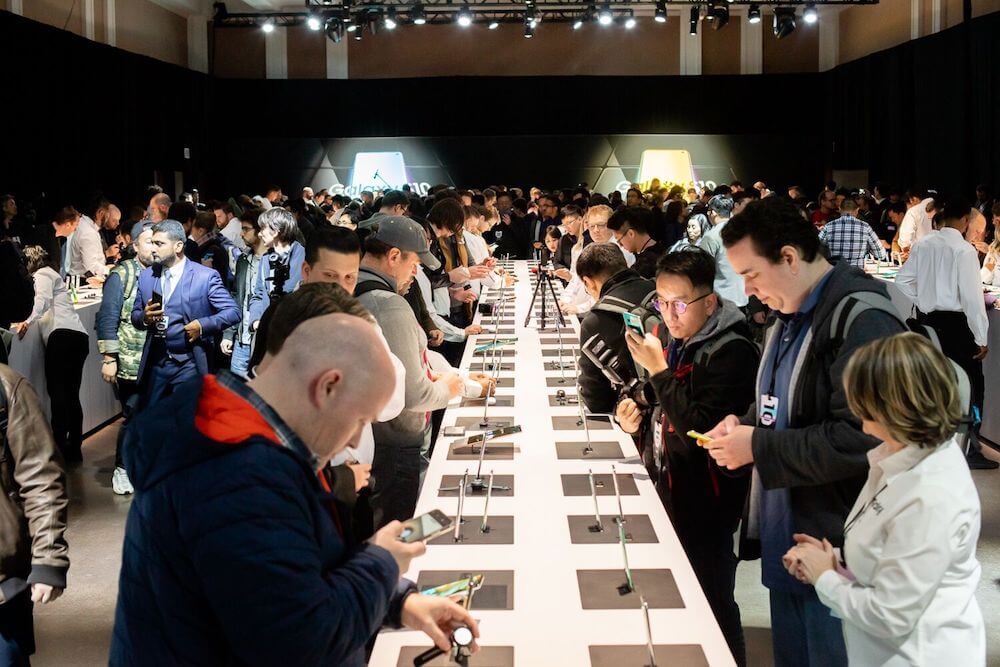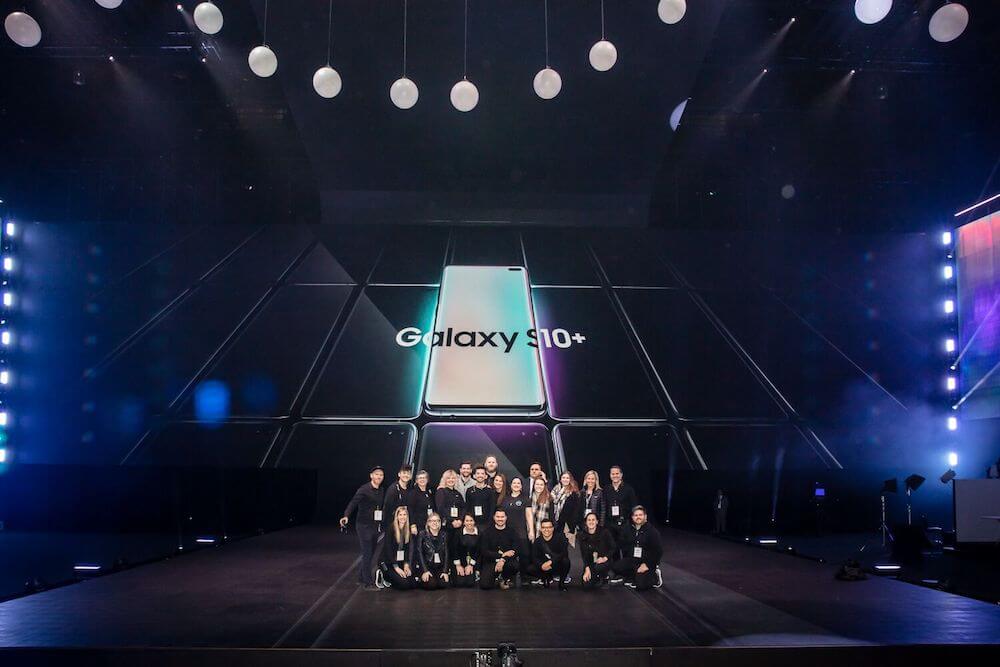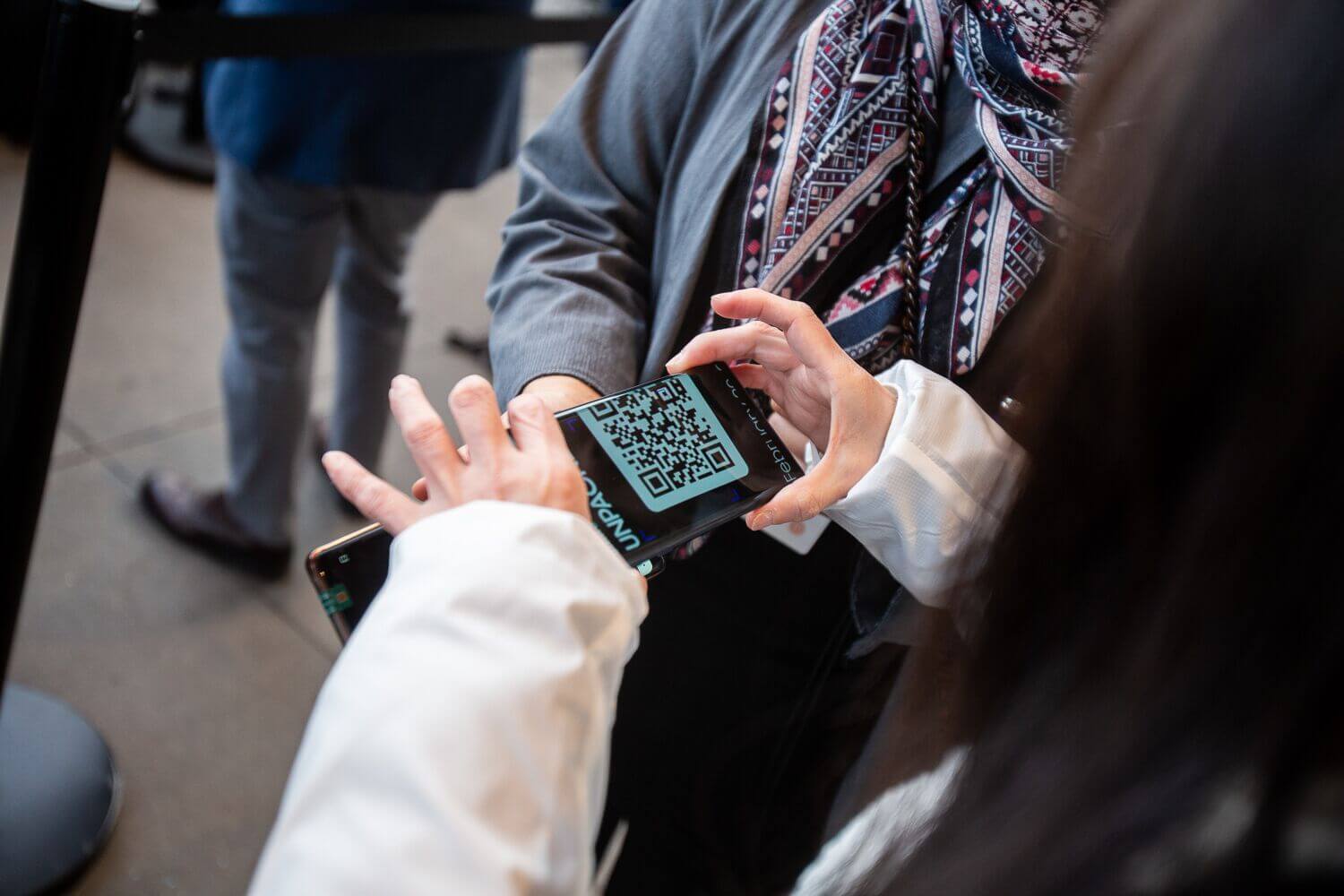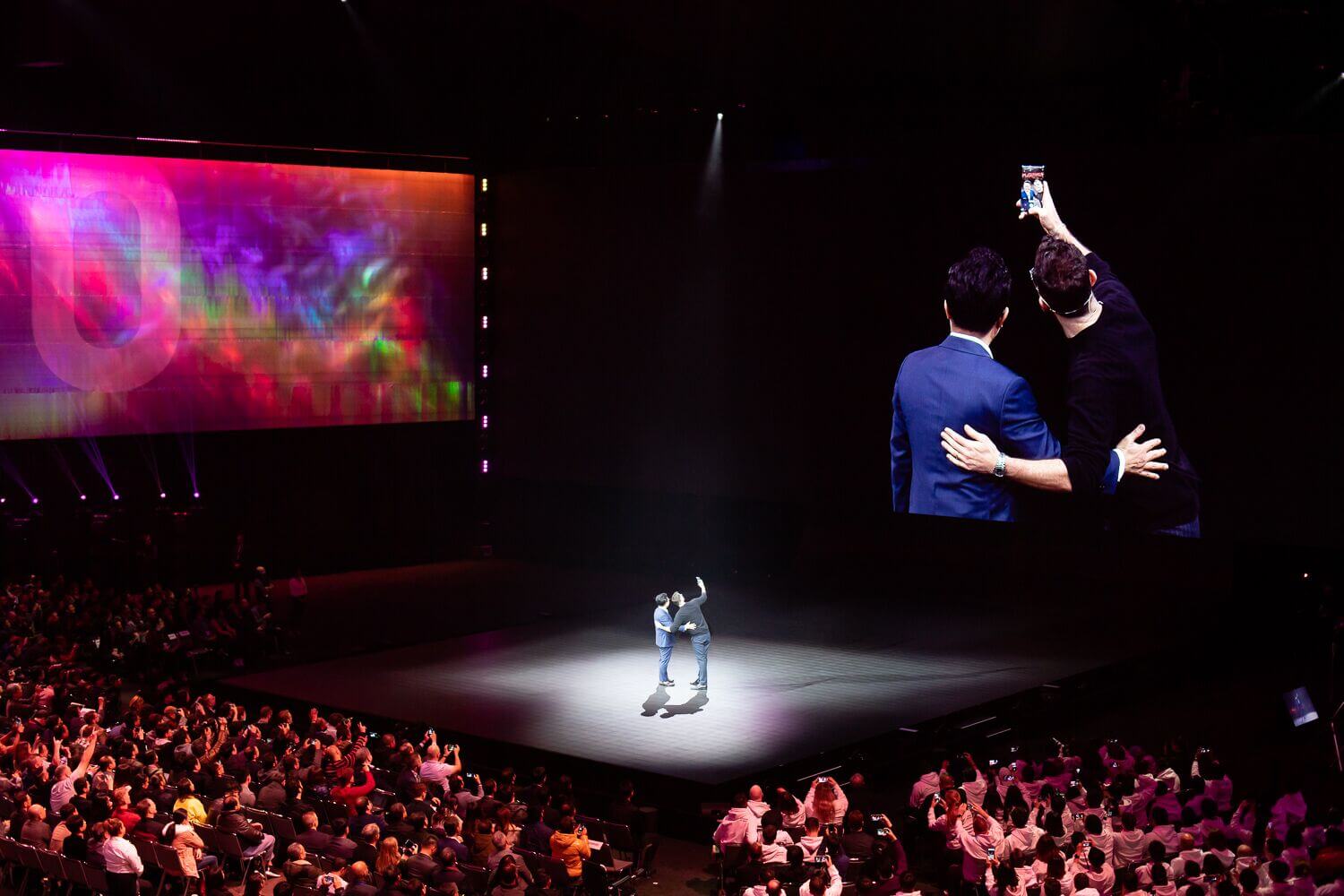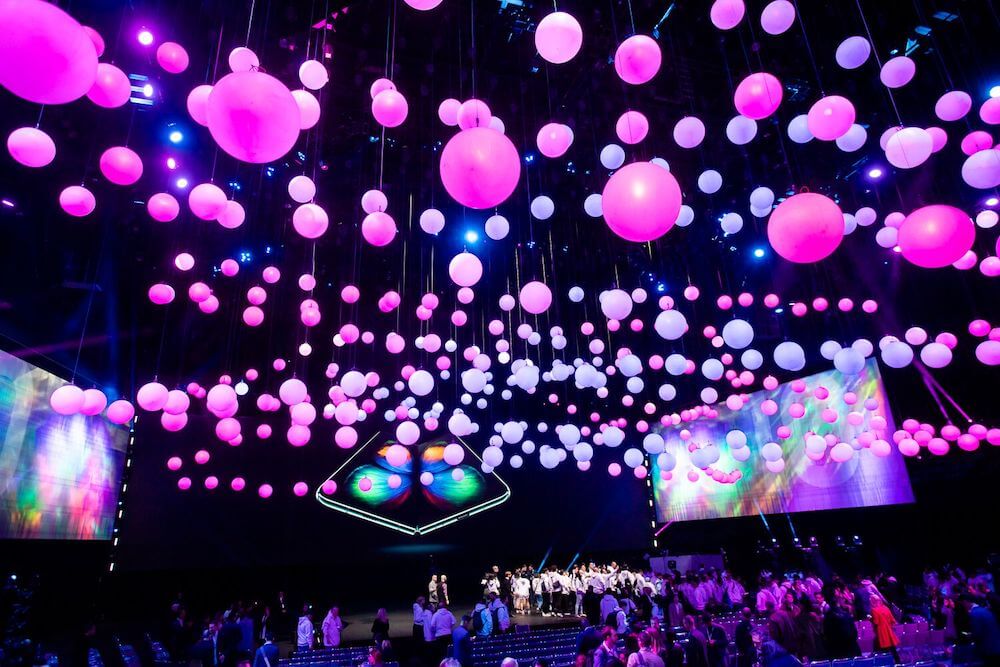
Galaxy Unpacked’s environments delivered on the wow factor for its tech-savvy in-person and online audiences.
Business event organizers know full well the power of live events — it’s like preaching to the choir. But now, leaders in other industries are singing from the same hymn sheet. Events that provide unique experiences for — and emotionally engage — attendees have become crucial for building relationships with both business and consumer audiences. In fact, 77 percent of respondents — 700-plus marketing professionals across Fortune 500 companies, agencies, and vendors — said that experiential marketing has proven to be the most effective form of marketing for their brands, according to the “2019 State of Experiential Research Study,” produced by Agency EA, a brand experience agency based in Chicago.

Leah Judge
“It’s no secret that traditional advertising has been suffering and digital users are numb to banner ads,” said Leah Judge, author of Agency EA’s “2019 Experiential Marketing Trend Report,” a companion report to the research study. “Content marketing is effective but it’s a very cluttered space — people don’t have time to sift through the noise or find the high-value information.” In contrast, authentic experiences provide lasting, emotional attachments to particular brands or organizations.
“Experiences are very immersive and audiences are craving them,” Judge said. “A person may not remember the details of an event they go to, but they’ll always remember how it made them feel. And other traditional advertising channels just can’t leverage that the same way.”
This past February, Samsung partnered with Cheil Worldwide and Agency EA to produce the 10th annual Galaxy Unpacked, a live experience that celebrated the 10th anniversary of the Galaxy phone and introduced a number of products, including the Galaxy S10 and Galaxy Fold. A full-capacity crowd of around 3,000 experienced the show at San Francisco’s Bill Graham Civic Auditorium, and another 44 million global viewers watched via livestream. Within a month after the event, the online recording had been viewed more than 4 million times.
Related: ’10 Trends in Experiential Events’
Galaxy Unpacked demonstrates the ability of an experiential event to captivate audiences both in person and online. It required a complex approach that included multiple partnerships, advanced technologies, compelling content, and paying constant attention to the attendee experience. Agency EA broke it down for Convene.
Stages That Shine
One of the top 10 experiential marketing trends uncovered in Agency EA’s “2019 Experiential Marketing Trend Report” is the shift toward creating stages that will make an impression both on site and online. Because many events draw attendees both in person and through livestreaming or on-demand video, it’s crucial to design stages and keynote addresses that will wow broader audiences, including virtual, allowing them to have an equally cutting-edge experience that mimics being there in person. Doing so means leveraging advanced technologies and unique stage designs.
At Galaxy Unpacked, organizers created a one-of-a-kind stage that didn’t just display content but also allowed participants — online and in person — to feel as if they were truly part of the experience. The five-part LED-paneled stage with canopy and floor pieces was constructed to replicate the unfolding of the Galaxy Fold, a foldable smartphone and one of the most anticipated product reveals of the Unpacked event.

Erin Behbehani
The display also included 484 individually rigged kinetic globe lights, scenic elements, and innovative lighting design to create awe-inspiring moments that accentuated the products. Those products were displayed in close-up to every audience member with a huge hero screen, measuring 114 feet wide by 34 feet tall, and a rigged overhead canopy, measuring 40 feet by 40 feet, which displayed product demonstrations and other content in real time. Because the stage itself was composed of five massive LED panel screens, presenters could literally walk across the content as it was displayed. Overall, screen content spanned more than 2,100 square feet with pixel resolutions of 9,000 to 2,400, according to Erin Behbehani, senior account executive at Agency EA.
To ensure that every attendee — including virtual audience members — enjoyed a seamless experience, the event employed a 12-camera strategy. Outside the venue, three broadcast trucks were stationed to support camera production and direction, audio programming, captioning, and media syndication via satellite to six continents. During the show, organizers coordinated a two-way handoff with a satellite viewing party in London as a way of spotlighting Samsung’s global reach.

Jessica Yarbrough
Like many B2B events, Galaxy Unpacked is an annual affair, so there’s a certain amount of pressure on organizers to make each version feel new, Jessica Yarbrough, account supervisor at Agency EA, said. “Keeping it fresh requires pushing boundaries and building partnerships with other professionals,” she said, “such as engineers, architects, and designers to create a compelling stage design that will work.”
Compelling Content
High-tech stages and screens only wow audiences if they’re displaying powerful, attractive content. As an event primarily developed for product launches, Galaxy Unpacked has the advantage of new, flashy technology to keep audiences engaged. This year, six new Galaxy products were unveiled, including the Galaxy S10, Fold, Buds, Fit, watch, and tablet.
Cheil, a marketing solutions company headquartered in Seoul, South Korea, designed the presentation content. Agency EA worked closely with Cheil to guide the technical specifications. The two partners imagined best ways to present that content and executed their plans together, aiming to create multiple climactic moments throughout the event. The two agencies jointly developed a strategic-reveal sequence that educated and entertained the audience for a full 90 minutes while maintaining a high level of energy and excitement. The teams crafted an event narrative and used never-before-seen videos, presentations from Samsung employees and industry-leading partners, and animated graphics to bring it all to life. The show was complex, featuring approximately 1,000 different theatrical cues (specific actions at specific times) — double the number of the standard corporate show.
In addition to seeing the products revealed on the main stage, attendees could see the products in use at the secondary demonstration stage. Upclose, 3D camera angles on the secondary demo stage allowed attendees to get a first-person perspective of the technology in action, adding more depth to their experience.
“There was a lot of work in developing all of the content to be displayed on these screens to make sure that it would not only come across and look beautiful for the people in the audience, but also for all of the people at home,” Behbehani said, “especially because we knew the majority of our viewers were going to be viewing this from the livestream.”
Practice Makes Perfect
Even the most compelling content requires practice to ensure effective presentation. “Things evolve and change in the event industry, but the thing that never does is that you can’t over-prepare or over-rehearse,” Yarbrough said.

Elise Farrington
At Galaxy Unpacked, new launches and new technology take center stage. “Unlike other brands that host many conferences, Samsung builds anticipation and holds two events per year, which keeps people watching,” said Elise Farrington, senior account executive at Agency EA. “The new technology isn’t muddled with other experiential aspects; they really just focus on their products.”
Because the product launches and demonstrations are the focal point, exhaustive preparation was critical. “As a live show, it was 90 minutes of in-person experience, and we had to create something that was new, different, compelling, and fresh,” Yarbrough said, “but that we had modeled in the 3D system, had rehearsed live, and had tested everything, so that when it came down to show time, we knew exactly what to expect.”
The team used Priava software to test all content and presentations online before the show, which helped in determining the best positions and camera angles to make sure everything would be visible for all audience members — in-person and virtual, Behbehani said.
In addition, she said, the team hired a demonstration expert to work with the camera crew to choreograph each product demonstration. The camera crew and live presenters practiced every product demo for close to 50 hours to get each one just right.
Inspiring Influencers
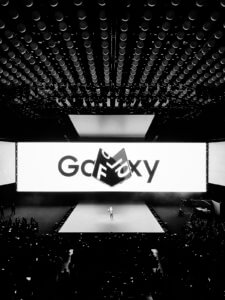
The stage at Galaxy Unpacked.
While all eyes are on Samsung’s new products and features showcased at Galaxy Unpacked, the people who use those products and the brands that partner with them are equally important. Traditionally, B2B events have sold sponsorships to help underwrite costs, but experiential events often take a more B2C approach, developing more robust partnerships with outside organizations or individuals, leveraging key partnerships to boost visibility and the perception of their offerings and brand.
For instance, in addition to product demonstrations, Galaxy Unpacked featured presentations from Instagram head Adam Mosseri and Verizon CEO Hans Vestberg, as well as YouTube influencer duo Coisa de Nerd, who demoed video-editing software Adobe Premiere Rush on a Galaxy S10. “Samsung made it clear to us that the goal of their Galaxy product is to bring their full ecosystem to life, showing everything a phone can do, and you can’t show everything a phone can do unless you get other brands involved,” Yarbrough said. “Having the right influencers helped tell the story.”
In addition to putting partners that complement its products on stage, Samsung invited the Samsung Member community, a group of select consumers. This select group had access to a front-row experience that they could share with their networks and audiences, further helping tell the story of the event.
Like Samsung, many brands and organizations are becoming more selective about influencers and other partners. “Event hosts really want to make sure that the partners that are there are highly relevant to both their audience and also to their brand and their brand message and the event message,” Judge said.
By identifying partners and thought leaders who share similar values and who can advocate for their message, event producers can increase awareness of both their event and their partners. But those partner activations have to be intentional. “It’s not just sponsoring the Wi-Fi or the F&B; it’s something that’s very specific to that brand,” Judge said. “It’s helpful for retaining partners year after year because they’re getting more ROI.”
Which in turn, helps attendees get greater ROE — return on experience.
- Download Agency EA’s “2019 State of Experiential Research Study.”
- Download Agency EA’s “2019 Experiential Marketing Trend Report.”
CMP Credit
Receive one clock hour of certification credit by reading the articles from our July Convene CMP Series.

